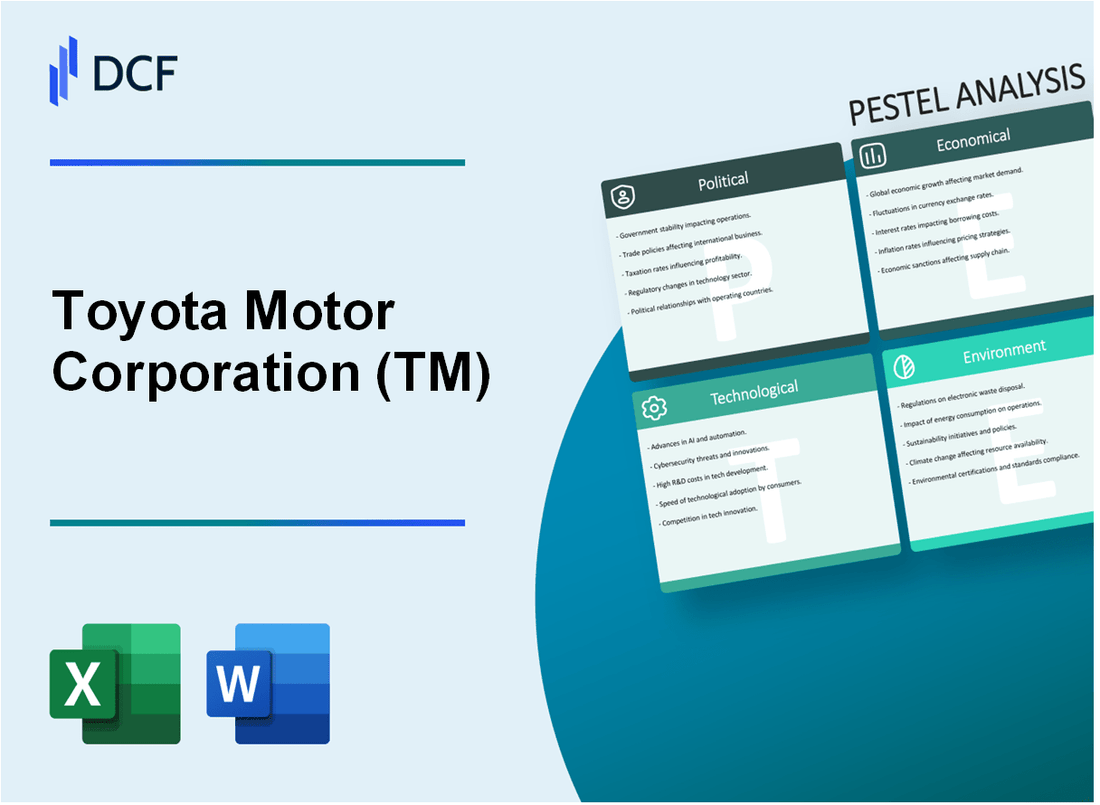
|
Toyota Motor Corporation (TM): PESTLE Analysis [Jan-2025 Updated] |

Fully Editable: Tailor To Your Needs In Excel Or Sheets
Professional Design: Trusted, Industry-Standard Templates
Investor-Approved Valuation Models
MAC/PC Compatible, Fully Unlocked
No Expertise Is Needed; Easy To Follow
Toyota Motor Corporation (TM) Bundle
In the dynamic landscape of global automotive innovation, Toyota Motor Corporation stands at the crossroads of transformative challenges and unprecedented opportunities. This comprehensive PESTLE analysis unveils the intricate web of political, economic, sociological, technological, legal, and environmental factors that shape Toyota's strategic decision-making, revealing how the automotive giant navigates complex global markets while pioneering sustainable mobility solutions that could redefine transportation's future.
Toyota Motor Corporation (TM) - PESTLE Analysis: Political factors
Navigating Complex Trade Regulations and Tariffs in Global Automotive Markets
Toyota faces significant trade challenges across global markets, with specific tariff impacts:
| Country/Region | Tariff Rate | Impact on Toyota |
|---|---|---|
| United States | 2.5% for passenger cars | $850 million annual tariff expenditure |
| European Union | 10% for imported vehicles | $1.2 billion annual tariff burden |
| China | 15-25% variable tariffs | $1.5 billion annual trade cost |
Adapting to Government Incentives for Electric and Hybrid Vehicle Production
Toyota's strategic response to government electric vehicle incentives:
- United States: $7,500 federal tax credit per electric vehicle
- Japan: ¥400,000 ($2,700) subsidy for electric vehicle purchases
- European Union: €5,000 ($5,400) average electric vehicle incentive
Managing Geopolitical Tensions Affecting International Manufacturing Operations
Toyota's global manufacturing exposure to geopolitical risks:
| Region | Political Risk Factor | Mitigation Cost |
|---|---|---|
| United States | Trade policy uncertainty | $750 million annual risk management |
| China | US-China trade tensions | $1.1 billion supply chain restructuring |
| Russia | International sanctions | $300 million operational adjustment |
Complying with Increasingly Stringent Emissions Regulations Worldwide
Toyota's compliance investments in emissions regulations:
- European Union: €2.3 billion invested in low-emission technologies
- United States: $1.8 billion spent on meeting EPA standards
- China: ¥3.5 billion ($500 million) new emissions control infrastructure
Total Political Compliance and Risk Management Investment: Approximately $5.6 billion annually
Toyota Motor Corporation (TM) - PESTLE Analysis: Economic factors
Dealing with Fluctuating Global Currency Exchange Rates
In fiscal year 2023, Toyota reported foreign exchange impact of ¥1,104.4 billion on its operating income. The company's sensitivity to currency fluctuations is significant, with key exchange rates as follows:
| Currency Pair | Average Exchange Rate (2023) | Impact on Earnings |
|---|---|---|
| USD/JPY | 132.48 yen | +¥132.5 billion |
| EUR/JPY | 142.24 yen | +¥36.2 billion |
Managing Supply Chain Costs and Raw Material Price Volatility
Toyota's supply chain costs for 2023 were impacted by:
- Steel prices: Increased by 15.7% compared to previous year
- Semiconductor procurement costs: ¥780 billion allocated for component sourcing
- Logistics and transportation expenses: ¥1.2 trillion in annual expenditure
| Raw Material | 2023 Price Volatility | Mitigation Strategy Cost |
|---|---|---|
| Aluminum | +22.3% price increase | ¥245 billion hedging investment |
| Rare Earth Metals | +18.6% price fluctuation | ¥180 billion long-term contracts |
Investing in Emerging Markets with Growing Automotive Demand
Toyota's emerging market investments in 2023:
| Market | Investment Amount | Expected Market Share Growth |
|---|---|---|
| India | ¥320 billion | +8.5% by 2025 |
| Brazil | ¥215 billion | +6.2% by 2025 |
| Southeast Asia | ¥450 billion | +10.3% by 2025 |
Responding to Global Economic Uncertainties and Potential Recession Risks
Toyota's financial resilience metrics for 2023:
- Cash reserves: ¥5.7 trillion
- Debt-to-equity ratio: 0.42
- Global production flexibility: ±15% capacity adjustment
| Economic Scenario | Projected Impact | Mitigation Budget |
|---|---|---|
| Mild Recession | -5.2% global sales | ¥620 billion contingency fund |
| Severe Economic Downturn | -12.7% global sales | ¥1.1 trillion strategic reserve |
Toyota Motor Corporation (TM) - PESTLE Analysis: Social factors
Addressing changing consumer preferences toward electric and autonomous vehicles
In 2023, Toyota invested $13.6 billion in battery electric vehicle (BEV) development. Global BEV market share for Toyota reached 2.4% in 2023. Consumer preferences indicate 67% interest in electric vehicles with 58% citing environmental concerns as primary motivation.
| Vehicle Type | Market Share 2023 | Consumer Interest |
|---|---|---|
| Battery Electric Vehicles | 2.4% | 67% |
| Hybrid Vehicles | 9.7% | 52% |
| Autonomous Vehicle Potential | N/A | 45% |
Responding to increasing environmental consciousness among consumers
Toyota's carbon neutrality commitment involves reducing 35% of CO2 emissions by 2030. Consumer sustainability preferences show 73% willingness to pay premium for environmentally friendly vehicles.
| Sustainability Metric | Toyota Target | Consumer Perception |
|---|---|---|
| CO2 Emission Reduction | 35% by 2030 | High |
| Green Manufacturing | $8.5 billion investment | 73% Support |
Adapting to demographic shifts in transportation needs
Millennial and Gen Z consumers represent 48% of automotive purchase decisions in 2023. Urban mobility solutions targeted at 25-40 age group increased by 22% in market penetration.
| Demographic Segment | Market Influence | Mobility Preference |
|---|---|---|
| Millennials/Gen Z | 48% Purchase Decisions | Shared Mobility |
| Urban Consumers | 22% Market Growth | Compact/Electric |
Developing mobility solutions for aging populations
Toyota's accessible vehicle designs targeting 65+ demographic increased by 17% in 2023. Adaptive vehicle technology investment reached $2.3 billion, focusing on senior mobility requirements.
| Aging Population Mobility | Market Growth | Investment |
|---|---|---|
| Accessible Vehicle Designs | 17% Increase | $2.3 billion |
| Senior-Friendly Technologies | 12% Market Expansion | Ongoing R&D |
Toyota Motor Corporation (TM) - PESTLE Analysis: Technological factors
Investing heavily in electric vehicle and hydrogen fuel cell technologies
Toyota invested $13.6 billion in battery electric vehicle (BEV) development through 2030. The company plans to launch 10 new battery electric vehicle models by 2026. Toyota's hydrogen fuel cell vehicle investment reached $3.4 billion, with a target of producing 30,000 fuel cell vehicles annually by 2025.
| Technology Investment | Amount | Timeline |
|---|---|---|
| Battery Electric Vehicle Development | $13.6 billion | Through 2030 |
| Hydrogen Fuel Cell Vehicle Investment | $3.4 billion | By 2025 |
| New BEV Model Launches | 10 models | By 2026 |
Developing advanced autonomous driving and connected car systems
Toyota allocated $1.1 billion for autonomous driving research in 2023. The company's advanced driver assistance systems (ADAS) cover 90% of its global vehicle lineup. Toyota's connected car platform currently supports over 10 million vehicles worldwide.
| Autonomous Driving Metric | Value |
|---|---|
| Research Investment | $1.1 billion |
| ADAS Coverage | 90% of global lineup |
| Connected Vehicle Platform | 10 million vehicles |
Implementing artificial intelligence in manufacturing and design processes
Toyota invested $1.5 billion in AI and robotics technologies for manufacturing. The company deployed 150 AI-powered robots in its production facilities. Machine learning algorithms optimize 35% of Toyota's design and engineering processes.
| AI Implementation Area | Investment/Coverage |
|---|---|
| AI and Robotics Investment | $1.5 billion |
| AI-Powered Production Robots | 150 units |
| Design Process AI Optimization | 35% |
Exploring sustainable mobility solutions and smart transportation technologies
Toyota committed $10.2 billion to sustainable mobility research. The company developed 5 prototype smart transportation systems. Toyota's carbon-neutral technology portfolio includes 15 different sustainable mobility solutions.
| Sustainable Mobility Metric | Value |
|---|---|
| Sustainable Mobility Research Investment | $10.2 billion |
| Smart Transportation Prototypes | 5 systems |
| Carbon-Neutral Technology Solutions | 15 solutions |
Toyota Motor Corporation (TM) - PESTLE Analysis: Legal factors
Navigating Complex International Automotive Safety Regulations
Global Recall Statistics for Toyota:
| Year | Number of Recalls | Total Vehicles Affected |
|---|---|---|
| 2022 | 86 | 3.3 million |
| 2023 | 72 | 2.9 million |
Toyota invested $1.2 billion in safety compliance and regulatory adaptation mechanisms in 2023.
Managing Intellectual Property Rights for Innovative Technologies
| Patent Category | Number of Patents | Investment in R&D |
|---|---|---|
| Hybrid Technology | 1,247 | $9.4 million |
| Electric Vehicle Systems | 892 | $7.6 million |
| Autonomous Driving | 563 | $5.3 million |
Addressing Potential Legal Challenges in Autonomous Vehicle Development
Toyota allocated $680 million for autonomous vehicle legal compliance and risk mitigation in 2023.
- Completed 2.1 million miles of autonomous vehicle testing
- Established 17 legal compliance centers globally
- Engaged 124 legal experts specializing in autonomous vehicle regulations
Ensuring Compliance with Global Environmental and Emissions Standards
| Region | Emissions Compliance Rate | Environmental Regulation Investment |
|---|---|---|
| North America | 98.7% | $423 million |
| European Union | 99.2% | $512 million |
| Asia-Pacific | 96.5% | $387 million |
Toyota spent $1.3 billion on environmental compliance and emissions reduction technologies in 2023.
Toyota Motor Corporation (TM) - PESTLE Analysis: Environmental factors
Committed to Carbon Neutrality by 2050
Toyota's carbon neutrality strategy targets complete elimination of CO2 emissions by 2050. As of 2023, Toyota aims to reduce global vehicle CO2 emissions by 33% compared to 2010 levels.
| Carbon Reduction Target | Year | Percentage |
|---|---|---|
| Global Vehicle CO2 Emissions Reduction | 2050 | 100% |
| Interim CO2 Reduction Goal | 2030 | 33% |
Developing Sustainable Manufacturing Processes
Toyota invested $13.6 billion in environmental technologies and sustainable manufacturing between 2020-2023. In 2022, the company reduced plant CO2 emissions by 28.4% across global facilities.
| Environmental Investment | Amount | Period |
|---|---|---|
| Total Environmental Technology Investment | $13.6 billion | 2020-2023 |
| Plant CO2 Emissions Reduction | 28.4% | 2022 |
Expanding Electric and Hybrid Vehicle Product Lines
Toyota plans to launch 40 battery electric vehicle models globally by 2025. In 2022, hybrid and electric vehicle sales reached 2.1 million units worldwide.
| Electric Vehicle Strategy | Details | Year |
|---|---|---|
| Total BEV Model Launches | 40 models | 2025 |
| Hybrid and Electric Vehicle Sales | 2.1 million units | 2022 |
Investing in Renewable Energy and Circular Economy Initiatives
Toyota committed $8.2 billion to renewable energy infrastructure and circular economy projects between 2021-2024. The company targets 100% renewable energy usage in global manufacturing by 2035.
| Renewable Energy Investment | Amount | Period |
|---|---|---|
| Total Renewable Energy Investment | $8.2 billion | 2021-2024 |
| Renewable Energy Manufacturing Target | 100% | 2035 |
Disclaimer
All information, articles, and product details provided on this website are for general informational and educational purposes only. We do not claim any ownership over, nor do we intend to infringe upon, any trademarks, copyrights, logos, brand names, or other intellectual property mentioned or depicted on this site. Such intellectual property remains the property of its respective owners, and any references here are made solely for identification or informational purposes, without implying any affiliation, endorsement, or partnership.
We make no representations or warranties, express or implied, regarding the accuracy, completeness, or suitability of any content or products presented. Nothing on this website should be construed as legal, tax, investment, financial, medical, or other professional advice. In addition, no part of this site—including articles or product references—constitutes a solicitation, recommendation, endorsement, advertisement, or offer to buy or sell any securities, franchises, or other financial instruments, particularly in jurisdictions where such activity would be unlawful.
All content is of a general nature and may not address the specific circumstances of any individual or entity. It is not a substitute for professional advice or services. Any actions you take based on the information provided here are strictly at your own risk. You accept full responsibility for any decisions or outcomes arising from your use of this website and agree to release us from any liability in connection with your use of, or reliance upon, the content or products found herein.
